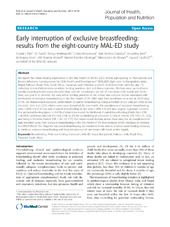| dc.description.abstract | We report the infant feeding experiences in the first month of life for 2,053 infants participating in “Malnutrition and Enteric Infections: Consequences for Child Health and Development” (MAL-ED). Eight sites (in Bangladesh, India, Nepal, Pakistan, Brazil, Peru, South Africa, Tanzania), each followed a cohort of children from birth (by day 17), collecting detailed information on infant feeding practices, diet and illness episodes. Mothers were queried twice weekly regarding health status, breastfeeding and the introduction (or no) of non-breast milk liquids and foods. Here, our goal is to describe the early infant feeding practices in the cohort and evaluate factors associated with termination of exclusive breastfeeding in the first month of life. With data from enrollment to a visit at 28-33 days of life, we characterized exclusive, predominant or partial breastfeeding (using a median of 6-9 visits per child across the sites). Only 6 of 2,053 infants were never breastfed. By one month, the prevalences of exclusive breastfeeding were < 60% in 6 of 8 sites, and of partial breastfeeding (or no) were > 20% in 6 of 8 sites. Logistic regression revealed that prelacteal feeding (given to 4-63% of infants) increased the likelihood of partial breastfeeding (Odds Ratio (OR): 1.48 (95% confidence interval (CI): 1.04, 2.10), as did the withholding of colostrum (2-16% of infants) (OR: 1.63:1.01, 2.62), and being a first-time mother (OR: 1.38:1.10, 1.75). Our results reveal diversity across these sites, but an overall trend of early transition away from exclusive breastfeeding in the first month of life. Interventions which introduce or reinforce the WHO/UNICEF Ten Steps for Successful Breastfeeding are needed in these sites to improve breastfeeding initiation, to reinforce exclusive breastfeeding and delay introduction of non-breast milk foods and/or liquids. | en_US |

